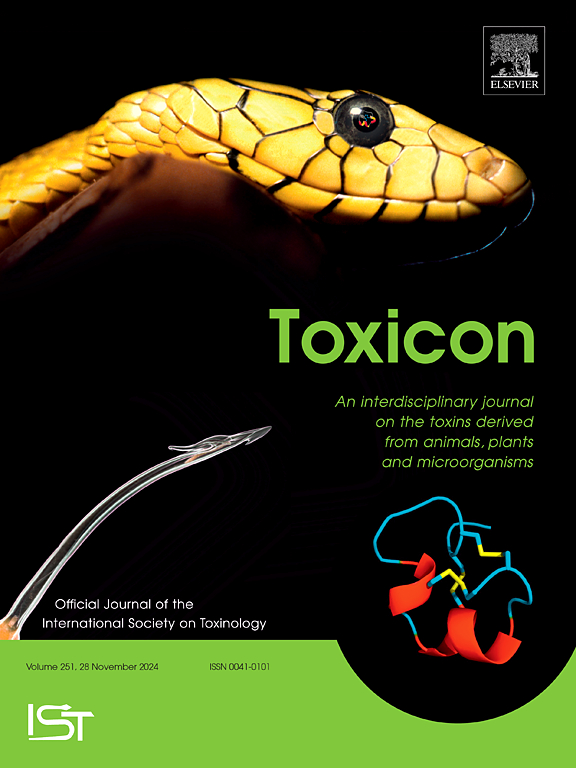通过炎症途径和表观遗传修饰探索伏马菌素B1的心脏毒性潜力:一个小综述
IF 2.6
4区 医学
Q2 PHARMACOLOGY & PHARMACY
引用次数: 0
摘要
本文综述了伏马菌素B1 (FB1)的心脏毒性作用,特别是其对鞘脂代谢、炎症和表观遗传学的影响。FB1是镰刀菌产生的一种真菌毒素,主要污染谷物,对人类和动物的健康构成不利风险;然而,其致病能力仍有待发现,特别是其加剧和引起心血管疾病的能力。它通过抑制神经酰胺合成酶来破坏鞘脂代谢,导致细胞功能障碍,并导致高血压和最终的心力衰竭等疾病。FB1负责改变炎症反应,从而增加促炎细胞因子,如IL-6和IL-1β,这有助于心血管疾病。此外,FB1诱导显著的表观遗传变化,包括DNA超甲基化、组蛋白修饰(如H3K9me2和H3K9me3增加)、组蛋白乙酰转移酶活性抑制以及microRNA表达谱的变化。这些表观遗传改变可以沉默或激活炎症基因,加剧疾病进展。因此,本综述强调需要进一步研究以阐明FB1、炎症、表观遗传修饰和心脏毒性之间的联系,这可能导致更好的策略来管理FB1相关的不良健康风险。本文章由计算机程序翻译,如有差异,请以英文原文为准。

Exploring the cardiotoxic potential of fumonisin B1 through inflammatory pathways and epigenetic modifications: A mini review
This review is centered around the cardiotoxic effects of fumonisin B1 (FB1), particularly its impact on sphingolipid metabolism, inflammation, and epigenetics. FB1 is a mycotoxin produced by Fusarium fungi, which mainly contaminates cereal grains and poses an adverse health risk to both humans and animals; however, its disease-causing capabilities remain to be uncovered, specifically its ability to exacerbate and cause cardiovascular disease. It disrupts sphingolipid metabolism by inhibiting ceramide synthase, leading to cellular dysfunction and contributes to conditions such as hypertension and eventual heart failure. FB1 is responsible for an altered inflammatory response, whereby it increases pro-inflammatory cytokines such as IL-6 and IL-1β, which contribute to cardiovascular diseases. Moreover, FB1 induces significant epigenetic changes, including DNA hypermethylation, histone modifications such as increased H3K9me2 and H3K9me3, inhibition of histone acetyltransferase activity, and changes in microRNA expression profiles. These epigenetic alterations can silence or activate inflammatory genes, exacerbating disease progression. This review thus highlights the need for further research to elucidate the connections between FB1, inflammation, epigenetic modifications, and cardiotoxicity, which could lead to better strategies for managing FB1-related adverse health risks.
求助全文
通过发布文献求助,成功后即可免费获取论文全文。
去求助
来源期刊

Toxicon
医学-毒理学
CiteScore
4.80
自引率
10.70%
发文量
358
审稿时长
68 days
期刊介绍:
Toxicon has an open access mirror Toxicon: X, sharing the same aims and scope, editorial team, submission system and rigorous peer review. An introductory offer Toxicon: X - full waiver of the Open Access fee.
Toxicon''s "aims and scope" are to publish:
-articles containing the results of original research on problems related to toxins derived from animals, plants and microorganisms
-papers on novel findings related to the chemical, pharmacological, toxicological, and immunological properties of natural toxins
-molecular biological studies of toxins and other genes from poisonous and venomous organisms that advance understanding of the role or function of toxins
-clinical observations on poisoning and envenoming where a new therapeutic principle has been proposed or a decidedly superior clinical result has been obtained.
-material on the use of toxins as tools in studying biological processes and material on subjects related to venom and antivenom problems.
-articles on the translational application of toxins, for example as drugs and insecticides
-epidemiological studies on envenoming or poisoning, so long as they highlight a previously unrecognised medical problem or provide insight into the prevention or medical treatment of envenoming or poisoning. Retrospective surveys of hospital records, especially those lacking species identification, will not be considered for publication. Properly designed prospective community-based surveys are strongly encouraged.
-articles describing well-known activities of venoms, such as antibacterial, anticancer, and analgesic activities of arachnid venoms, without any attempt to define the mechanism of action or purify the active component, will not be considered for publication in Toxicon.
-review articles on problems related to toxinology.
To encourage the exchange of ideas, sections of the journal may be devoted to Short Communications, Letters to the Editor and activities of the affiliated societies.
 求助内容:
求助内容: 应助结果提醒方式:
应助结果提醒方式:


